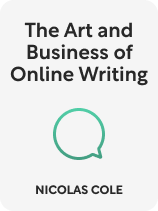

This article is an excerpt from the Shortform book guide to "The Art and Business of Online Writing" by Nicolas Cole. Shortform has the world's best summaries and analyses of books you should be reading.
Like this article? Sign up for a free trial here.
Ever dreamed of becoming a professional writer? Is the idea of turning your passion into a career too good to be true?
Nicolas Cole’s The Art and Business of Online Writing details his journey from amateur blogger to successful writer. Cole believes anyone can achieve this with consistency and knowledge of the online writing world.
Continue reading for an overview of this book that can help make your writing dreams a reality.
Overview of The Art and Business of Online Writing
Many people feel their dream of being a professional writer is too abstract to become reality. However, Nicolas Cole’s The Art and Business of Online Writing argues otherwise. Cole uses his own story as testament—he went from a nobody blogger to a successful career writer in only a few years. According to him, anyone can create a successful online writing career—be it in blogging, copywriting, poetry, or any other digitally published format—as long as they do two things: write consistently and understand the world of online writing. In The Art and Business of Online Writing, Cole lays out his guide to establishing an online writing career based on his experience and success.
Cole is a top online writer and entrepreneur. He writes regularly on Quora and Medium, has been featured in publications like TIME, Forbes, and Fortune, and was a regular writer for Inc. before turning his attention toward entrepreneurial ventures. He’s the founder of ghostwriting agency Digital Press and co-creator of Ship 30 for 30, an online community dedicated to helping people get started writing online. Cole’s also the author of The Art and Business of Digital Writing, The Art and Business of Ghostwriting, How to Market a Love Story, and more.
We’ve organized Cole’s tips and tricks into a three-part guide to becoming a successful online writer. We’ll discuss the technicalities of writing successfully, gaining an audience, and eventually profiting from your content.
Part 1: Write Online Consistently
Cole argues that the first step in becoming a successful online writer is consistently writing and publishing your material online. This, he says, requires you to publish something at least once every other week—ideally more. At the beginning of his career, Cole gained popularity quickly by publishing something every day—and he argues that, the more frequently you publish, the quicker your career will progress. Writing consistently in this way is important for a few reasons:
- It indicates whether you have the drive and desire to become a writer. If you struggle to write consistently or dread the process, writing likely isn’t for you.
- It improves your technical abilities (like organization and word choice) and helps you discover your niche as a writer—your topic, audience, and style.
- It’s the only way to build an audience. If you’re not writing consistently, it’s nearly impossible to gain popularity and credibility because your content will get lost among the thousands of other pieces published every day.
In the following sections, we’ll discuss Cole’s tips for how to start writing.
Tip #1: Choose Where to Post
Before you start writing, you must choose an effective platform to publish your content on. Cole says to avoid publishing content on a personal website or blog—this sets you up for failure because there’s no way to bring traffic to your site unless you already have an audience.
Instead, write on a social platform that 1) already has a large user base and 2) provides you with data to measure your success—for example, the number of views, likes, and comments each of your publications gets. This allows you to measure what’s working for you so you can determine your niche and produce more of that content. Some of the top sites Cole recommends are Quora, Medium, LinkedIn, and Substack. Choose the one most suited to the type of content you want to write, he says, and be ready to branch out to others as you gain popularity or the site loses popularity.
Tip #2: Have a Clear Focus for Your Piece
According to Cole, writing a successful piece of content first requires you to have a clear focus for what you’re writing. You must determine the piece’s topicform, and content, as well as your credibility on the topic.
If you don’t have a niche yet, Cole recommends choosing a few different topics (or genres) you’re interested in and alternating between them—for example, poetry, relationships, and book reviews.
Next, choose the form of writing you’ll share. Cole describes five forms of successful writing:
1) Actionable guides provide detailed “how to” instructions. For example, a guide on how to write an essay might explain how to brainstorm, organize, use proper language, and so on.
2) Opinion pieces share your opinion and explain why you’re credible—for example, a guide outlining how to choose a contractor coming from someone who’s learned from their past mistakes.
3) Lists are usually simplified ways of informing people about something. For example, a list piece might provide 15 easy recipes that use tomatoes.
4) Stories are pieces of content that pull readers in through entertaining narratives and sometimes also aim to inform through storytelling. For example, you might tell a story about how your backpacking trip through Greece taught you what you actually need to pack versus what you think you need.
5) Source of credibility content pieces can be any of the above, but they’re written and read because the author is a primary source of credibility in the area. For example, an Olympic runner might write an opinion article or list about who they think will win Olympic track events.
Then, you must choose the content of the piece—what are you giving the reader? Cole says there are seven types of content: explanations, habits, mistakes, lessons, tips, stories, or timely events (for example, sharing breaking news).
Finally, what gives your writing credibility? Cole says there are three reasons you could be credible—you’re an expert on the topic, you’re sharing insights from other experts, or you’re just sharing your opinion.
Let’s put Cole’s ideas together in one hypothetical piece. In this piece, your focus might be a list explaining how to know your relationship is going well. The content of the piece might be explanations of signs to look for. Finally, your credibility might be that you’re a relationship therapist.
Tip #3: Create a Compelling Title
The next factor in writing successfully, says Cole, is creating a title that sparks a reader’s curiosity and draws them in. Compelling titles contain three components: what the piece is about, who it’s relevant to, and what it will provide readers (answers, solutions, and so on).
This requires you to determine who your audience will be. Your audience may be a niche group, or it may be the general public. If your audience is niche—say, people with depression who are in a relationship—your title should be more specific, for example “5 Signs Your Relationship Is Healthy If You’re Depressed.” If your audience is the general public (anyone in a relationship), your title might be more general, for example “5 Signs Your Relationship Is Healthy.” Both titles specify what the article’s about and what the reader’s gaining—signs their relationship is healthy—while also specifying who will benefit from the piece.
Tip #4: Organize Your Piece Effectively
Finally, Cole says you must organize your piece effectively so that it catches the reader’s attention. To do this, it must be clear and concise, as well as having a high rate of revelation—in other words, it should reveal new information quickly so the reader stays interested and feels they’re gaining something from reading. There are three main sections that you must decide how to organize: the introduction, the body, and the conclusion.
The Introduction
The introduction outlines what the piece is about and what it’s offering so readers can decide whether it’s relevant to them and if they trust you to provide good information. Cole says you should aim for your introduction to be five lines long:
1) One opening sentence: This sentence should aim to express the main point of the piece in roughly 10 words. For example, in an article titled “5 Signs Your Relationship Is Healthy,” your opening sentence might be: “Every healthy relationship depends on five key factors.”
2) Three expanding sentences: These sentences should 1) clarify or elaborate on the opening sentence, 2) reinforce your point with a form of credibility (for example, a source or logic), and 3) wrap up the argument and prepare for the concluding sentence. For example: “Many relationships may have three or four of these five factors and be stable. However, being stable isn’t the same as being healthy. Lacking even one factor can create weakness in the dynamic that introduces the potential for major relationship issues to develop down the road.”
For longer or more complex pieces that may require further explanation in the introduction, you can include one or two additional descriptive sentences.
3) Concluding sentence: This should wrap up your point. For example, the concluding sentence of the relationship article could be, “It’s better to strengthen your relationship health now than face problems that could lead to a breakup later.”
The Body
The body of your piece houses your main points. For example, the main points in the relationship article are the five signs you’re promising to discuss. Cole says the length and organization of each point in the body largely depends on how many points you’re making. To keep the reader engaged, the average length of a piece should be around 1,000—including more points means you have fewer words available to describe each one.
For example, if you have five points to make, each point can use the five-line format you used for your introduction: 1) Clearly state the point, 2) expand on or clarify the opening, 3) state why the reader should care (or why the point is important), 4) wrap up the argument, 5) conclude with why this point matters to your specific audience.
On the other hand, if you have 20 points, you’ll need to make the discussion of each point as short as possible to fit them all. For example, if the point is about having trust, you might say “Trust is a sign of a healthy relationship. Mutual trust makes both parties feel secure in the relationship. A lack of trust can lead to false accusations and hurt feelings, which put the relationship at risk.”
The Conclusion
Cole says there are three main ways you can conclude your piece:
1) A summary: This is most useful when your discussion is long or complex and readers may need a recap of the most important points.
2) A cliffhanger: This leaves the reader wanting more. Cliffhangers only require a few lines—imagine you’re metaphorically “dropping the mic.” For example, your conclusion in the relationship article might be: “These are the five factors that research tells us indicate relationship health. They may not be the only factors you need for your relationship to succeed, but they’re the ones that have the power to make or break your relationship.” This cliffhanger makes the reader want to know more—about how they can improve their relationship or what other factors they need to succeed. They’ll be likely to seek out more articles written by you.
3) A strong opinion: This is one of the best options if you want to end with a strong final point. The concluding point should connect all the points you’ve already made. For example, your final point in the relationship article could be: “If you want your relationship to last, you need to establish relational health at the start. Otherwise, you’re laying the groundwork for big issues later on.” You should organize this paragraph using the same format as a body paragraph.
Part 2: Choose Your Niche
Once you’ve been writing consistently online for about six months, Cole says you should gather metrics and use those to focus your efforts on a specific niche. To be successful in the world of online writing, you must stand out by doing something unique and being the best at what you do. This requires you to determine where you’re the most successful and dedicate yourself to that area—if you spread yourself too thin by writing about too many different topics or for too many different audiences, you’ll never become the best at anything, just decent at a lot of things.
Step #1: Gather Data and Get Focused
Cole says the first step in determining your niche is looking at the likes, dislikes, views, and comments on your posts and seeing which topic is most popular with your audience. This is because your audience determines your fate—if they continue to read your content, you’ll gain popularity and credibility and can start making money. To grow and maintain that audience, you must continue giving them what they want.
For example, imagine that your posts about relationships are getting the most views, likes, and comments. While you don’t have to stop writing other things, you should dedicate the vast majority of your time to relationship pieces because this is the content that builds your audience.
Step #2: Narrow Down Your Topic
Once you’ve determined the topic you’ll focus on, Cole says you must narrow down your topic into a niche by getting as specific as possible with your subtopic, audience, and style. This is an ongoing process throughout your career—the longer you’ve been writing and the more data you gather using the above process, the more you can narrow down your niche until you eventually create an entirely new niche that no one else offers.
Subtopic
First, Cole says you must narrow the scope of your topic into a subtopic. For example, if the general topic is “relationships,” subtopics you might try are “relationship management” or “breakup management.” Under a subtopic like “relationship management” you could then create numerous articles with content like how to spot communication issues, how to spice up the relationship, and so on. Cole says you should continue trying out subtopics and use your data to determine which one to focus on for your niche.
Audience
Specifying your audience—who you’re writing for—will help you narrow down your subtopic further until it becomes a niche. For example, if you determine that the subtopic that works best for you is relationship management, especially the articles written for people with mental illness, you should try creating more content for this audience. Your subtopic will narrow into the niche “relationship management for people with mental illness.”
You could then narrow this down even further, for example, by targeting your advice toward people with a specific mental illness like depression. Use data in this way to continually focus your writing throughout your career.
Style
Finally, narrow your niche further by choosing your style. Cole says that your style will exist somewhere on a range between educating and entertaining. For example, if you’re a hard educator, your content might be very formal and include scientific research. If you’re a hard entertainer, your content might be largely opinion-based, with humor and drama to highlight your points. Your style can exist anywhere in between.
To narrow down your niche into something completely unique, Cole says you should adopt a style that’s unusual for your niche. For example, if your niche is “relationship management for people with depression” and most writers in this niche use a highly educational style, you can stand out by incorporating elements of entertainment like stories and humor.
Part #3: Establish Your Business
Cole says that once you’ve narrowed down your niche and have an audience, you can begin to turn your writing into a business—that is, to build a name for yourself and start making money from your content. To do this, you’ll need to direct people away from whatever platform they’re reading your content on (for example, Quora or Medium) and toward your personal platform—for example, a website or book. We’ll discuss how to capture readers on your personal platform and how to profit from this.
Step #1: Endorse Yourself
Cole says the first step in directing people toward your personal platform is learning how to endorse yourself without being obvious about it. Being low-key is crucial, according to Cole, because the more you endorse yourself the less people listen. The key to endorsing yourself is doing so in a way that genuinely benefits your reader.
For example, imagine you’re writing a piece titled “5 Signs Your Depressed Partner Is Unhappy With Your Relationship.” You can subtly endorse yourself by saying: “If you recognize these signs, you may want to have a conversation with your partner about existing issues.” Within that sentence, you can hyperlink to another article you wrote about how to have a conversation about relationship issues, which both helps the reader and plugs another one of your articles.
Cole says it’s OK to be more obvious sometimes—for example, directly saying that you wrote a book that might help your reader, or mentioning you’re an expert on the topic and they might want to check out your library. The key to doing this is making it clear that it’s for their benefit.
Step #2: Pillar Pieces
Next, Cole says you must create “pillar pieces” that attract people to your personal platform. For example, if your niche is “relationship management for people with depression,” your pillar piece will be an ultimate guide to this topic containing all the crucial information you’ve written about in different articles. This piece might cover topics like how to know if you have depression when you’re in a relationship, behaviors and feelings you might have, how to talk about relationship issues, and so on. Your pillar piece should include even more information and details than the individual articles combined—for example, additional research, personal stories, or interviews.
Once you have pillar pieces and start directing people onto your platform, says Cole, you should create even more in-depth content based on your pillar pieces, such as master guides, online courses, or newsletters. These resources should be free, but you should require the user’s email to sign up so you can capture them as “permanent” audience members.
Choose Your Money-Making Method
Once you have a solid audience visiting and utilizing content from your personal platform, you can start integrating money-making methods. Cole says there are three main methods you can use to start monetizing.
Method #1: Paid Access
The first method Cole suggests to make money off your content is to create even more detailed content from your pillar pieces, master guides, and free courses that you can sell to people. Everything up to this point should be free to entice people and gain their trust and consistent attention. Once you have this audience, you can create something that offers them even more than everything you’ve already combined. For example, you could offer a subscription-based newsletter, a paid interactive course, or a book (like The Art and Business of Online Writing).
Method #2: Employment
The second method Cole suggests to make money off your content is to use your proven skills to write for other people. Having a personal platform with your own content library and a stable and consistently engaged audience proves to people that you’re a successful writer. You can now offer to share your talents with others for a fee. For example, you can be a content writer for a company or a ghostwriter for individuals who have credibility through expertise but not the writing skills to share that expertise.
Method #3: Advertising
The final method Cole suggests to make money off your content is incorporating advertising into your personal website. This method works in a few ways. First, you can have companies pay you to allow their ads to appear on your content. Second, you can have brands pay you to directly endorse their products (for example, recommending users try a particular online therapy company in your relationship articles for people with depression). Third, you can become an affiliate—this is like the second option, but you make money through commissions every time someone uses your link to visit their platform or purchase their product.

———End of Preview———
Like what you just read? Read the rest of the world's best book summary and analysis of Nicolas Cole's "The Art and Business of Online Writing" at Shortform.
Here's what you'll find in our full The Art and Business of Online Writing summary:
- The two things you must do to create a successful online writing career
- How often you should publish online
- Where to post your content for maximum impact






